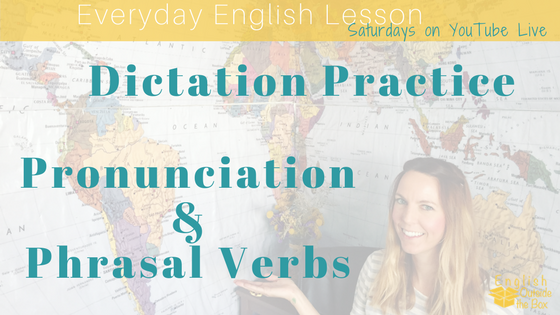
Everyday English: Dictation Practice to Learn Phrasal Verbs & Pronunciation
Every Saturday, I have been giving a live “Everyday English” lesson on my YouTube channel to teach more everyday English skills. These (everyday) English skills help learners use English more comfortably and confidently in daily life. We’ve reviewed a lot of important points over the past several weeks, skills like grammar, pronunciation, test prep, phrasal verbs, vocabulary and idioms, etc…
This last week we changed things a little and did a dictation exercise to help students work on their listening skills, while also practicing pronunciation and learning phrasal verbs. This exercise was great because it not only gave listening practice and helped teach pronunciation and phrasal verbs, it also allowed new questions and difficulties to come up during the live lesson to review. This is why I love live lessons, for the chance to interact and connect with my English learners watching, and to provide a more valuable English resource.
So below is Saturday’s YouTube lesson replay for you to review this week. You can participate in the dictation challenge and check your listening skills and learn more about pronunciation and phrasal verbs.
In this lesson you will review:
- how the “H” sound drops in English
- the difference between CAN and CAN’T in pronunciation
- an effective way to learn phrasal verbs
Now, let’s review with today’s lesson notes.
Everyday English Pronunciation
The disappearing “H” in English
When we use the pronouns her (and him) in a sentence, we drop the “H” sound and link it with the previous word. So, in the video you heard:
I can tell her
However, it sounded like:
Ikin teller
tell her = teller
This will happen with other sentences/phrases with her (and again, him). Other examples could be:
I love her = Iluver
Call her = caller
Tell him = tellum
I’ll pay him = I’ll payum
The difference between CAN and CAN’T
A student watching live had asked about the difference between CAN and CAN’T, and wanted me to say the sentence “I can’t tell her.”
As you’ll hear in the video, the word CAN in a sentence is reduced to a word that sounds like “kin”.
I can tell her = Ikin teller
The word CAN’T in a sentence keeps the short vowel “a” sound, the same sound as the words “apple” and “ant”.
Another difficulty with these words, and why they can be confused is because of the ending -T in CAN’T. In American English, we cut that ending -T sound, so it’s not heard very easily when linked and reduced in a sentence. (*Watch and listen to the video to review*)
Everyday English Phrasal Verbs
So what did I say in the dictation challenge?
The first sentence I read was:
When did you whip her up some food?
There are not only various linking principles happening in this sentence (when did you = “whenjew” & whip her= “whipper“), this also gave you the opportunity to hear how a phrasal verb is used, before learning the definition.
This is an excellent way to learn new words in English because you’ll be able to recognize how they sound and how they’re used, which will help you use them more accurately and effectively.
Think about it for a second.
How many times have you learned a word from a book and misunderstood it when it was used in a movie, a TV show, or in a conversation that you were listening to? There is a very good chance that you have misread a word or didn’t know how it was reduced/linked in a sentence. If you aren’t familiar with how the word sounds, then you will probably miss the word being used and feel confusion.
This is why learning new language in context, with audio support is one of the best ways to learn!
What did I say in the second sentence of my dictation challenge?
The next sentence I read was:
I’ll whip her food up later.
Again, you were able to hear how the word was linked to other words in a sentence and how it was used grammatically (for example: the object “her food” was placed in between the verb ‘whip’ and the particle ‘up’).
What does this phrasal verb mean?
whip up = to prepare food quickly
Practice Makes Perfect
Now it’s your turn to practice what you’ve learned in the video and this lesson. In the comments below, or in the comments below the YouTube video, write new sentences using the phrasal verb “whip up”. Try and use new objects, differing time tenses, and more complex sentences to really challenge your English skills.
You can also practice repeating the sentences you heard me say in today’s video to shadow my pronunciation and practice linking sounds in American English.
Finally, I’d also like to invite you to get even more practice with phrasal verbs and your speaking skills in my new conversation club!
Come join:
The Phrasal Verb Conversation Club
This club is a monthly membership program where you will get weekly English materials and resources to more effectively learn, remember, and use English phrasal verbs. Each week will give you the opportunity to practice your speaking skills with speaking tasks, and connection with a speaking partner. Each month, we’ll meet together LIVE for a group conversation call.
This club will help you:
- learn and use more phrasal verbs in English
- improve your speaking and pronunciation skills
- find more opportunities to speak English in your daily life
- remember how to use more phrasal verbs in future conversations
The Phrasal Verb Conversation Club will help with a lot more, like your confidence and comfort using English in your day-to-day routine.
So if you’re ready to improve… come join me!
Join the conversation club here!
Until next time,


I loved that class. I didnt whip you up any food yet. But I will when you visit me. Bye